Bassdozer's Wisconsin Swimming Jigs

by Russ Bassdozer
This shows and tells product photos, product descriptions and
information for the lure models and colors that are (or have
been) available at BassdozerStore.com. Not all models and colors
shown are currently available, and exact specifications are
subject to change.
Note: Some of the following configurations may not all be
currently in stock. Some may be sold out at this time. Please
check online at www.BassdozerStore.com
for current availability of specific items below. Thank you for
your business.
Bassdozer's Wisconsin Swimming Jig Heads
Type: Wisconsin (Northern Style)
Sizes: 1/4 oz and 3/8 oz
Hook: 5/0 Mustad Ultra Point in both 1/4 and 3/8 oz



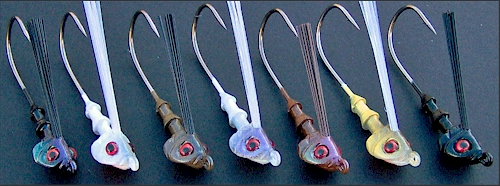
L to R: Black Sunfish, White Shad, Green Pumpkin, Natural Shad,
Brown Sunfish, Gold Shiner, Black.
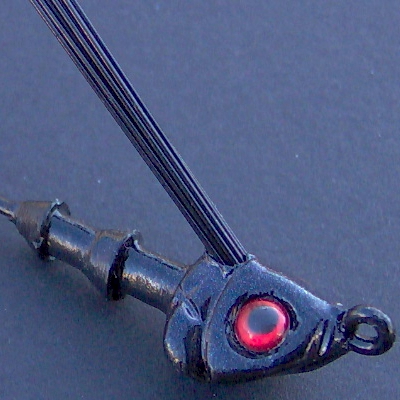
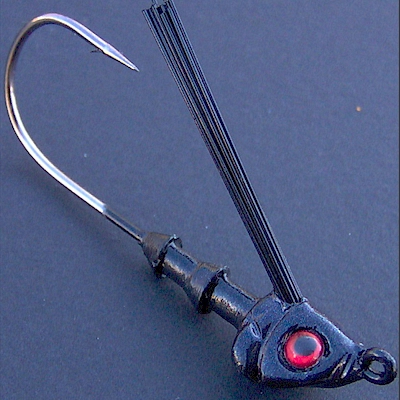
Swimming Jig Head ~ Black ~ 1/4 oz (5/0) or 3/8 oz (5/0)

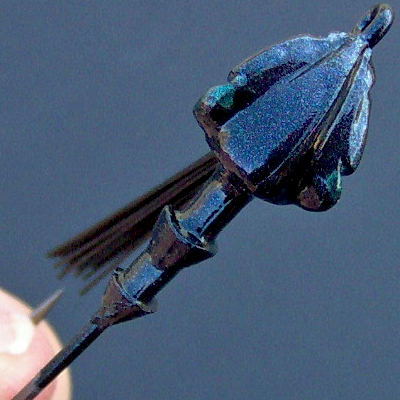
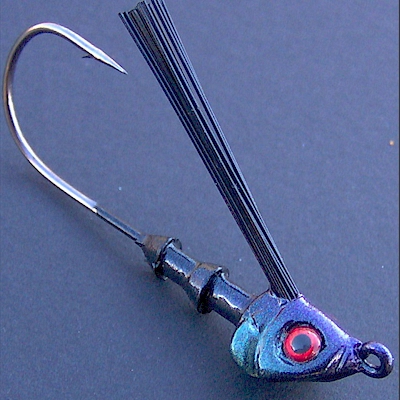
Swimming Jig Head ~ Black Sunfish ~ 1/4 oz (5/0) or 3/8 oz (5/0)
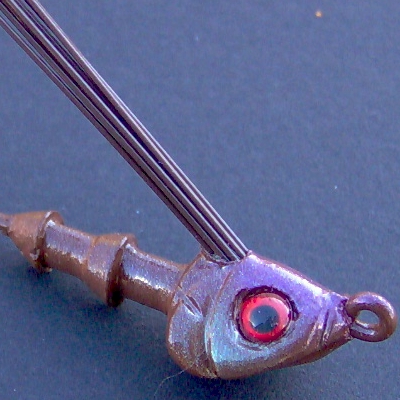

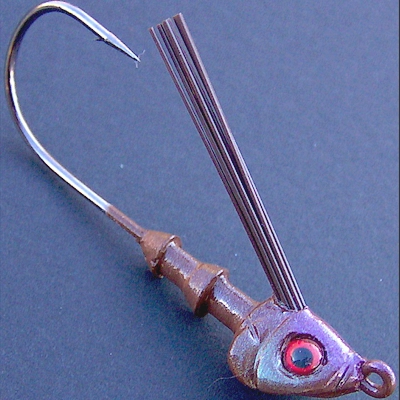
Swimming Jig Head ~ Brown Sunfish ~ 1/4 oz (5/0) or 3/8 oz (5/0)

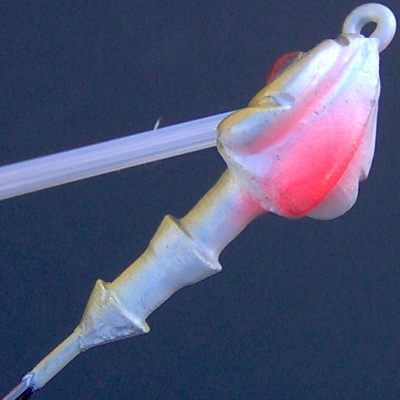
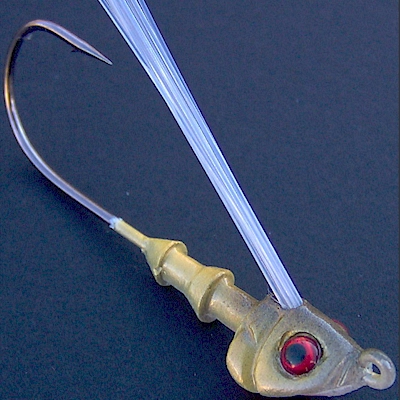
Swimming Jig Head ~ Gold Shiner ~ 3/8 oz only
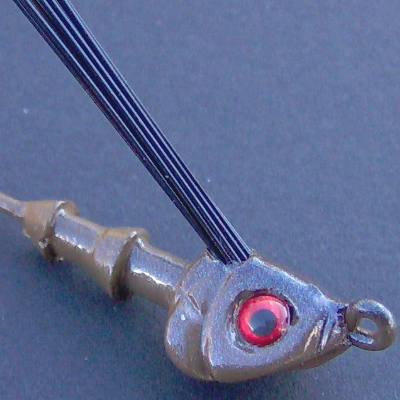

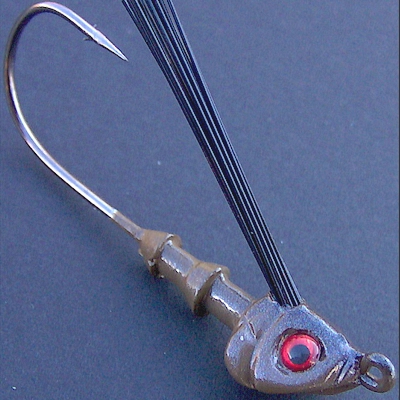
Swimming Jig Head ~ Green Pumpkin ~ 1/4 oz (5/0) or 3/8 oz (5/0)

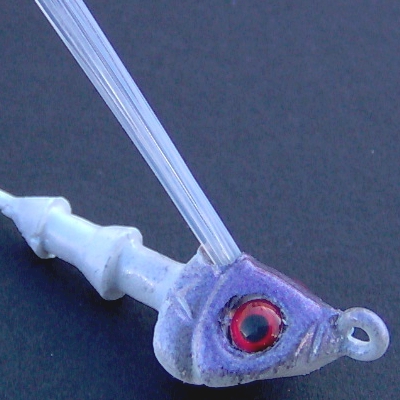
Swimming Jig Head ~ Natural Shad ~ 1/4 oz (5/0) or 3/8 oz (5/0)
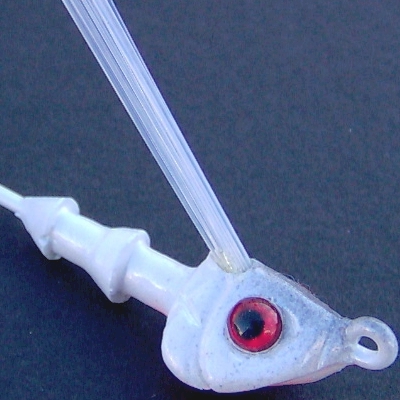


Swimming Jig Head ~ White Shad ~ 1/4 oz (5/0) or 3/8 oz (5/0)
Wisconsin Swimming Jigs with Thin Strand Skirts
Thin Strand Skirts. Made of the same silicone rubber as
regular skirts but the thickness of the material is thinner (it's
made from a flatter, thinner sheet of silicone to begin with) and
then each strand is cut much thinner. There are usually 60
strands per skirt versus 40-44 thinker strands on a regular
skirt.
Some anglers say the thin cut strands have more action or
movement. Whether that matters to fish, no one can prove. It's
true these skirts are lighter and more airy than standard skirts,
and have a more subtle quiver. But the main reason I use thin
strand skirts at times on Wisconsin style swimming jigs is not
because of any difference in skirt action - but because of the
difference in profile and water resistance.
The thinner strands are more streamlined, more fluid in the
water, and present a smaller profile. On a swimming jig, the thin
strand skirt lets the swimming jig balance more perfectly, the
skirt profile is more sheer or finesse-like - and that's often
what anglers seek in a Wisconsin style swimming jig skirt - a
sparser appearance and more subtle profile. The thin cut skirt
provides that.
And thin strand skirts really show off the all-important jig
trailer.
These thin strand skirts are also Hole-In-Ones, which means
the strands are sandwiched between an inner core hub and the
outer retainer band.
Hole-In-Ones are ultra high quality and you don't have to
worry about the skirts slipping off or the rubber bands failing
like with standard banded skirts.
The strands are also locked in place by the Hole-In-One, so
the strands can't move around or pile up on one side of the jig.
On delicately-balanced swimming jigs, the perfect placement of
each strand, plus the overall lighter, thinner skirt does not
affect the upright balance of a swimming jig as much as bulkier
standard skirts that could make a swimming jig run lopsided.
Perhaps best of all, the Hole-In-One causes the skirt to flare
or bulge out on both sides of the band. Many anglers feel that
flare gives more bounce or action to the strands.

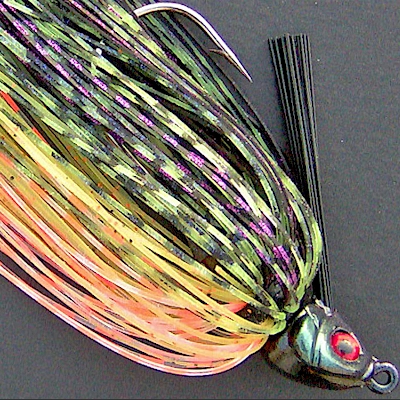
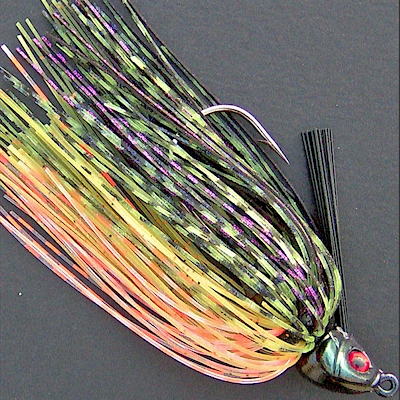
Swimming Jig ~ Bluegill ~ 1/4 oz (5/0) or 3/8 oz (5/0)
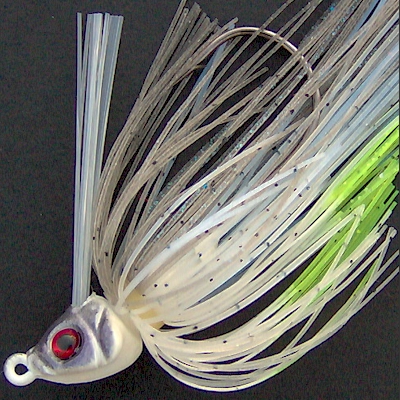

Swimming Jig ~ Chartreuse Shad ~ 1/4 oz (5/0) or 3/8 oz (5/0)

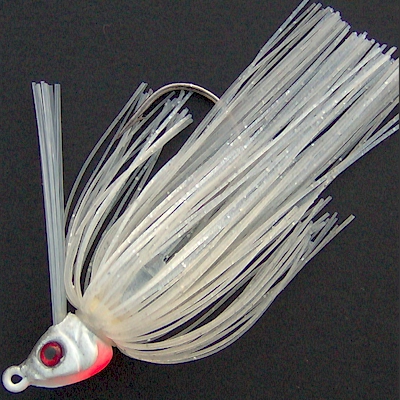
Swimming Jig ~ White Shad ~ 1/4 oz (5/0) or 3/8 oz (5/0)
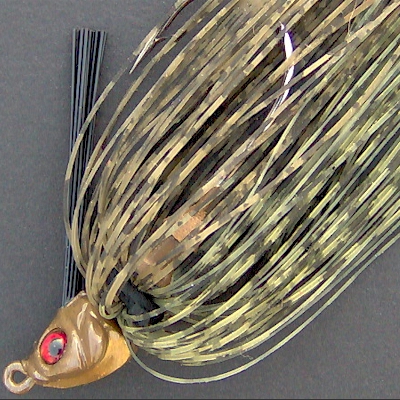

Swimming Jig ~ Watermelon ~ 1/4 oz (5/0) or 3/8 oz (5/0)

Swimming Jig ~ Green Pumpkin ~ 1/4 oz (5/0) or 3/8 oz (5/0)
Fishing Tips for Wisconsin Swimming Jigs
My familiarity with Wisconsin style swimming jigs stems back
to the year 2000, around when I first heard of them.
Word through the grapevine back then was that anyone bass
fishing on the Upper Mississippi River around Wisconsin, Iowa,
Minnesota and parts thereabouts, Tom Monsoor was the man to beat,
or more accurately, the man you couldn't beat, and he was winning
it all with his own home-made swimming jigs sweetened with Gary
Yamamoto single tail grub trailers.
An ardent bass fisherman, Tom Monsoor had innovated and
perfected the art of swimming jigs with devastating results.
Before Tom, you rarely ever heard of anyone swimming a jig. A jig
was almost exclusively a bottom contact bait before Monsoor. He
changed all that.
A couple of guys who knew Monsoor were the first to tell me of
his tactics and success. David Snyder, president then of the
Wisconsin State Bass Federation stated, "Many have tried to
duplicate or discover the secrets of swimming jigs from Tom
Monsoor, but few have learned all the pieces of the puzzle yet
from Tom."
A top regional bass pro, Jimmy Johnson, was another one who
had pursued this technique from day one, learning some parts of
it from Tom Monsoor, and also working with David Snyder to
hand-pour the specialized jigs required for the swimming
application.
"I had a mold machined along the lines of what I believe
to be representative of some of the earlier styles of jigs used
by Tom Monsoor. I can't say these are what Tom uses now, but they
are similar to some swimming jigs that Tom had used along the
way," said Dave Snyder at that time.
The shape Monsoor used, and that many others strived to make
their own molds for, was an elongated, tapered bullet nose jig.
Only two sizes were originally used by Monsoor - a 'light' 1/4 oz
size which saw duty most of the time since it 'floated' best over
thick grass, and a 'heavy' 3/8 oz size which was used
infrequently along deeper weed edges for instance.

Photos of my early swimming jig contacts circa 2001.
Key was the line tie eye angle, and jig hooks with the correct
angle were not available at that time. So anyone who wanted to
make a swimming jig had to first give each hook a special
treatment to heat and hand-bend the eye of each hook to the
proper angle. A 2/0 was commonly molded into the light, and a 3/0
in the heavy.
There seems to be a sweet spot when the line tie eye gets to a
low enough angle that ensures swimming action, but not so low of
an angle that the jig veers off on its side during the steady
swimming retrieve. So the hook eye angle was lowered almost to
the point of unbalancing the jig - and many jigs did prove to be
unbalanced once they came out of the mold, were painted and
dressed. As a final step, Tom Monsoor would test-swim them all
before he would use them, discarding any that were obviously
unbalanced, that listed or drifted to the side or were otherwise
not swimming quite right to Tom's experienced eye.
A certain jig is required. After all the effort that goes into
producing a jig, if the jig rolls off to the side, fish don't
want anything to do with it. In the end, if the jig doesn't swim
straight, it's no good.
To me, part of the problem in getting a swimming jig to be
stable is inherent in the rounded bullet body shape. Just imagine
if your bass boat had a rounded bow and rounded hull shaped like
the nose cone of a rocket ship. It wouldn't be very stable, would
it? Your bass boat would probably roll over upside down and veer
off in all sorts of directions, but not straight. That was an
issue I did not like with the traditional or customary pointy,
bullet-nosed swimming jigs used in Wisconsin - that borderline
lack of stability. It's just inherent in the round bullet shape
design that any little imbalance in the construction, the outcome
will be unstable in the water.
Also, because they could roll over if full 40-50 strand jig
skirts were used, Tom Monsoor tied his swimming jigs with 18
strands of silicone (not latex) rubber and he usually adds Mylar
strands for flash and contrast. The original reason for fewer
strands on Monsoor's (or other) swimming jigs is not for action
or visual appearance or swimming flutter. Fewer strands were
originally necessary since a full skirt will cause many
bullet-nosed swimming jigs to roll over on their sides and become
unbalanced, thereby ruining the fish-attracting and snag-avoiding
qualities of the jig. Therefore, Wisconsin style swimming jigs
were originally made with sparser skirts than usual - not for
action or attraction - but due to this inherent issue of
imbalance in the pointy-nosed bullet head shape combined with the
low angle of bend in the swimming jig hook eye.
Also, most bullet-nosed swimming jigs, the strands must be
tied firmly in place so the strands can't wiggle around and bunch
up on one side or the other. When the strands bunch up on one
part of the jig collar instead of being evenly distributed, what
happens? You guessed it, the inherent imbalance that will tip the
bullet-nosed style over, and any swimming jig that won't swim
straight up will dramatically reduce your chances a fish will
strike it. I can't tell you why, but it's true. Swimming jigs
that run lopsided or roll over are poor producers.
The Swimming Jigs in Bassdozer's Store
The swimming jigs in Bassdozer's Store are unique creations.
These were not modeled after Monsoor's or other swimming jigs on
the market. It's a true original jig design based on an
understanding of what's needed in order to run a stable swimming
jig through heavy cover without flipping over when it hits
something - or simply becoming unbalanced due to the shape. The
pointy, conical bullet nose jig simply isn't the best shape to do
that.
I just took what I knew from my own experiences at swimming
jigs with superb results for a few years, and then worked with
the moldmaker on what a swimming jig ideally needed to
accomplish, and here's the result. It's very stable and is the
only swimming jig I know actually shaped like a bass boat's bow
and keel underneath the jig head.
There are some strategic "cutting" angles that
enhance its ability to cut through cover even better. Again,
think of a high-performance bass boat and how its nose is
designed to cut through air and water. It is a very streamlined
design. This allows my jig to slide through, over and around
cover without fouling. In fact, it pushes itself off cover, due
to the wedge-like nature of the head. With other swimming jigs
when you have a conical bullet head hitting cover, it wants to
roll on the surface it touches, and keep contacting it, roll
across it through continuing to contact the surface. It doesn't
push itself off like the vee wedge shape I designed for coming
through cover. My jig has a "cutting" wedge shaped nose
to slice through cover and raised gill plates that extend out on
the sides to serve as cover "pushers" to shunt it off
cover it contacts.


The underside of these swimming jigs is remindful of a bass
boat's bottom, and is inherently stable.
Points about the Hooks Used
I call them "Wisconsin Swimming Jigs" since they
follow that state's local custom of a medium/heavy wire hook
(it's not a stout flipping hook) and they come in the lighter 1/4
and heavier 3/8 oz sizes as are customary in Wisconsin. I did,
however, big up the hook size to a 5/0 instead of the customary
smaller hooks, some as small as 2/0 or 3/0 that others may use.
Actually, the Mustad hook I use did not even exist until a couple
years ago. If you wanted a Wisconsin swim jig a few years back,
you had to heat and hand-bend every hook to get the eye angle.
Mustad made the hook I use now specifically for Wisconsin
swimming jig makers like me, so you would not have to bend each
hook yourself any longer. It's a special purpose hook Mustad
designed for making Wisconsin swimming jigs.


A medium/heavy wire hook is used - a big 5/0.
A number of big fish, up to and including ten pound plus bass
have been landed by customers on these jigs. They don't have a
heavy flipping hook. They have a medium heavy hook, so you can't
overpower them with too heavy a rod. But if you use a medium
heavy rod and 12, 14 or 16 lb test line, you'll be able to handle
the biggest bass no problem with these jigs.
Customer Steven Rockweiler of Luling, Louisiana says, "Great
products, Russ! I have been catching really big bass on your
Swimming Jigs. I caught 2 in one day, both over 10 lbs. The best
5 went over 37 lbs! Had an unreal day of fishing, thanks to your
Swimming Jigs!" - Steven Rockweiler
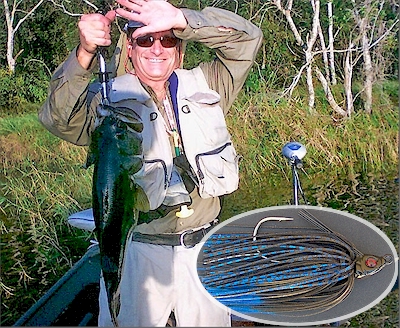
Customer Larry Rose of Texas says, "I caught this
nice nine plus in South Texas on your black blue swimming jig
rigged with a black blue (color #021) Yamamoto craw trailer on 10
pound test spinning tackle." It's not the greatest photo
angle, but you can see Larry's holding this fish up on a Boga
Grip scale, which is pretty accurate.
A Few Words on Skirts
The Wisconsin Swimming Jigs in Bassdozer's Store are stable
and balanced so that a full skirt (44 to 50 strands) may be used
on them and that fullness is generally desirable on these jigs.
Other swimming jigs may be made with less strands, but that's
because a full skirt would cause them to roll over. That's partly
the reason why many other swimming jigs must also be hand-tied -
because the balance is too unstable if the strands bunch up on
one side. I don't really have that problem in my head design, but
I favor using the modern Hole-In-One skirt which has each strand
sandwiched, locked and glued in place, so they can never move a
hair, never bunch up in one spot. Since my jig is so very stable,
I can use a full-size skirt without unbalancing it. In addition
to standard 5" skirts and 5" Hole-In-One skirts, I
heartily recommend the 5" and 4" Thin Strand skirts
with my Wisconsin Swimming Jigs. Thin Strand skirts present a
more streamlined baitfish profile that goes great on my Wisconsin
Swimming Jigs. A wide selection of these replacement skirts
are available in Bassdozer's Store.
Whenever skirts get discussed, the question always arise
whether latex (living) rubber or silicone rubber skirt strands
work best? To me, silicone works best. Believe me, I've tried and
tried to find some situation or time when latex (living) rubber
would catch more fish than silicone, but just never found that to
ever be the case. I'm not alone on this either. Tom Monsoor uses
silicone rubber, not latex rubber on his swimming jigs.
I don't know what to say about this since the popular myth
that latex is better or has more enhanced action than silicone is
still pretty strong today - even though almost all skirted lures
on the market are made of silicone. I can only equate it to years
ago, there was a similar debate and strong opinions that pork was
better as a jig trailer than soft plastic trailers. Pork was said
to be more natural, more supple, to swim or undulate better, to
be tougher than plastic trailers and so on. There were all rules
for when pork would excel over soft plastic as a jig trailer, but
all that has kind of faded now, along with pork. I can tell you,
it's not better for bass jigs. Pork certainly works but I have
never found any conditions or situations when pork produced
better than soft plastic. In fact, my conclusion is the opposite
- I believe that soft plastic trailers produce better catches.
And I believe that silicone skirts produce better catches on
swimming jigs.
Which brings us to the question of trailers...
Trailers A Must
Last but not least, I never fish a swimming (or any) jig
without a soft bait trailer. When it comes right down to it, the
jig head and jig skirt are only a means to attract fish close
enough over that they strike the trailer! Really. If you don't
believe me, fish a swimming jig (or any skirted jig) for a few
days with no trailer on it. You won't do as well.
In early 2004, Tom Monsoor had two top finishes on the
national FLW pro tour swimming his jigs, and that instantly
brought Monsoor's swimming jigs into national attention. It
wasn't long before many of the country's top pros were all
swimming jigs - and doing exceptional with them! The sudden and
huge national sensation with swimming jigs enabled Tom to get his
jigs made and marketed by a major vendor (Bass Pro Shops).
Monsoor didn't sign-off on the jigs until he felt they were being
produced perfectly. Yet he soon learned of a few customers who
complained that the jigs weren't producing fish. In every case,
Tom found that the unhappy anglers were not using trailers. So
always use one.
Single tail grubs are the traditional choice for Wisconsin
style swimming jigs.

From top down: Gary Yamamoto Stretch 40 (2-series), 4-inch single
tail (40-series) and 5-inch single tail (18-series)
Additionally, small swimbaits, double tail grubs, Swim Senkos
and other options work well on the swimming jigs in Bassdozer's
Store.
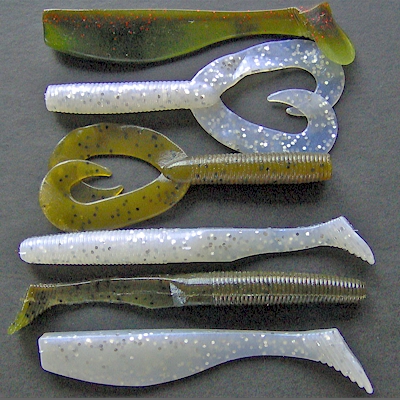
Shown: Gary Yamamoto's small swimbaits, pro double tail grubs
(16P-series) and small Swim Senkos can be used as trailers - with
or without silicone skirts.

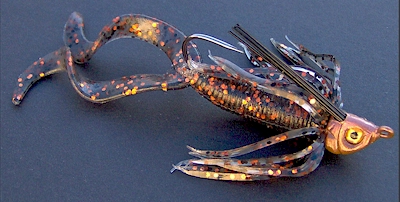
Also, never forget that plain hula grubs, plain single tails
grubs or small swimbaits all work great on the plain jig heads
too. You don't need to use a silicone skirt, just the jig head
and soft bait work fantastic!
Double Cone Cut Collar
The swimming jigs in Bassdozer's Store have double cone cut
collars. The first cone is to hold the silicone skirt firmly in
place. The second cone provides a full 360 degrees of grip to
hold the trailer securely.
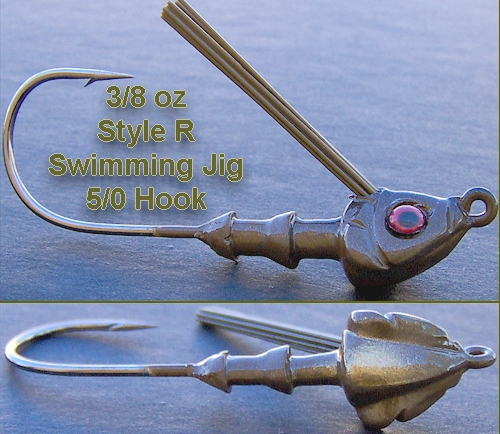
Double cone cut collar: Each cone cut provide a full 360
degrees of grip to hold skirts and trailers securely.
Fish Attractant a Must
Another necessary component to swimming jig presentation is
adding on attractant such as Megastrike - but only to the soft
plastic trailer, not on the jig head or skirt. The slippery
attractant is like a lubricant which keeps the tail from sticking
and helps the grub or trailer swim, flow and flex better. Then
when a fish gets near it, behind it, and when the fish gets close
enough to smell the scent trail, they devour the jig more.
Even if a bass strikes short and tears the thin tail off a
trailer, it will come back a second time to get the rest of the
swimming jig because of the taste of the torn-off tail. It smells
good enough to nip, the tail tastes good, and then they return to
strike again in order to eat the entire jig.
You'll learn to favor the days they tear the tail off. Learn
to let the first tentative bite pass by without setting the hook.
You'll lose the tail, but it's like letting them have an
appetizer or delicious hors d'oeuvre first. It gives you a
heads-up, a warning that you should ready yourself. They've
taste-tested the sacrificial tail, are convinced it's food, and
will return for the main course, hitting solidly this time.
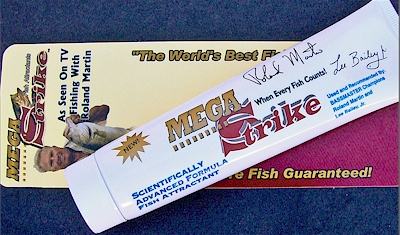
But scent attraction and taste are not the only reasons to use
MegaStrike. Another reason to use it is to give a glistening
life-like sheen to the trailer. This is especially true on
translucent colors, and the sheen coat heightens light hitting
the bait and it helps heighten the reflective sparkle flakes if
any.
Simply squeeze a small pea-sized glob of MegaStrike gel into
the plastic bag the trailer baits are packaged in. In this way,
the trailers all get a sparkly sheen coating, get a life-like
luster to them, and, if there are ten to twenty baits in the bag,
you do not need to stop fishing to re-apply fish attractant ten
or twenty times during the day. Only once.
Equally important, the lubricated baits tend to relax and
unwind any kinks or bends they may have gotten during storage.
You would not think it matters to a bass, but soft baits do catch
more fish when they are straight. They catch less fish when
kinked, bent or twisted badly. Anointing the baits in the bag
with MegaStrike will tend to return the baits back to the perfect
shape they were originally molded in, thanks to the restorative
effect that MegaStrike can have on soft plastics. And when bass
smell and taste it, they're hooked. Plus, applying a coating of
attractant in the bag instead of on the jig, helps keep the
individual skirt strands from getting congealed and stuck
together like poorly cooked spaghetti. The trailers in the bag
are well-coated, but the skirt strands don't get as greasy or
matted down.
Below is another story on swimming jigs that I had
originally written for Gary Yamamoto's Ezine Newsletter a few
years ago. It serves to highlight GYCB's single tail grubs as
trailers, and it gives additional insight into Wisconsin style
swimming jigs and tactics. Please enjoy!
Sink or Swim?
The experts keep telling us there's no such
thing as a magic lure. Still, we are always looking. Few of us
will ever find it. But at least one top pro angler, Tom Monsoor
from Wisconsin feels he may have discovered such a magic lure -
the swimming jig dressed with a Gary Yamamoto grub trailer.
Forever we've been sinking jigs and bouncing them
up and down on the bottom, feeling it imitates a crawdad. It took
Tom Monsoor to teach us all to swim jigs to imitate shad,
bluegill and assorted shore minnows. As fundamental as swimming a
jig sounds, it really wasn't done by anyone before Monsoor.
Monsoor's first inkling that he may be on to
something big began in the mid-1980's when he first began to
intentionally swim a jig. Steadily, Tom and his swimming jigs
grew to dominate tournaments within the northern states region of
Minnesota, Wisconsin, Iowa and Illinois. By the late 1990's,
Monsoor had perfected the swimming jig with devastating
tournament results. With a heavy onslaught of wins and top-tens,
Monsoor wore the BFL Great Lakes Division AOY crown from 1999
through 2001, and Monsoor netted the EverStart Series Northern
Division title in 2001. Some accounts credit Monsoor with over
one hundred local and regional tournament wins, all on his
swimming jig.
Not only did Monsoor believe he had a magic lure,
but the many competitors he crushed began to believe it too. They
desperately began to try to copy Monsoor's swimming jig the best
they could. Many co-anglers had been in the back of Tom's boat as
draw tournament partners. That's one way the word spread about
what Tom was doing. Yet Monsoor had played his money-making jig
close to his life vest. As a result, few knew the necessary
details of how or why Tom made or used them. Nevertheless, a
number of look-alikes - sparsely-skirted, bullet-nosed jigs with
low-angled hook eyes - began to appear everywhere in the North
Central states wherever Tom had whipped them.
By 2002, Monsoor stepped up to the national pro
level, and he has not seriously fished northern states regional
events since 2002. The pressure was off them, but the schooling
he gave his Northern brethren is still not forgotten. To this
day, the swimming jig is used heavily in the northern region
where Monsoor reigned. There isn't anyone fishing a tournament in
the area of Minnesota, Wisconsin, Iowa, Illinois who doesn't have
one, or more like a couple dozen swimming jigs in his bag.
Monsoor brought the swimming jig to national
attention in early 2004 when Tom had two top finishes swimming
jigs on the prestigious FLW Pro Tour. He backed up a second place
finish on Atchafalaya Basin, Louisiana with a third place finish
on Beaver Lake, Arkansas. It's puzzling that something so
fundamental and effective as swimming a jig had not been done
before. But truly, no one really did it before Monsoor.

A swimming jig is a different animal than other jigs.
Since 2004, thanks to Tom's example, many of the
USA's top pros have learned how to swim jigs. Top pros have
consistently scored high by swimming jigs in most top national
events since 2004. As a consequence, there are numerous brands of
swimming jigs on the market now. Most (not all) aim to be about
as close as possible to emulate Tom's swimming jig in a general
way. Most (not all) tend to have a bullet head, a low angle hook
eye, a slightly lighter wire hook and lighter fiberguard than
found on a flipping jig, for instance. Most tend to have a
sparser skirt with less strands in it. A sparse skirt is required
because a full skirt tends to upset the delicate balance caused
by the low angle eye of most swimming jigs. They'd veer off and
swim sideways instead of upright due to the water drag with a
full skirt. That's an inherent problem in most all bullet-nosed
swimming jigs, even those hand-made by the master Monsoor
himself. It's critical to balance the skirt material just right,
and less skirt material is necessary so the jig head doesn't roll
over or swim crooked. You wouldn't think it would matter to fish,
but truth is, fish don't want anything to do with swimming jigs
that roll over and don't stay upright.
With a good swimming jig design, it's not
uncommon to go through a dozen and discard the ones that don't
swim true. That's the price you pay for the privilege to fish
with the remaining jigs that do pass muster. When you get one
that is balanced perfectly, it will buzz across the surface like
a soft plastic frog or toad, and remain true and upright even on
high speed retrieves. But others, even out of the same mold, will
roll over and play dead. This is not something that applies only
to swimming jigs. Even the best crankbaits, topwaters or whatever
you care to name have below-average, average and above-average
performers in every dozen. If you don't weed them out, you will
waste your time fishing with them.
Swimming jigs excel for fishing in vegetation,
grass, reeds, brush or wood. Yes, they will work other ways, but
swimming jigs are at their best as shallow water weed and wood
lures. These are the choicest types of spots that fish favor on
any body of water, and practically every anglers knows that.
These shallow fish in prime spots know all about anglers, boats
and baits. They get peppered with lures, and have gone through
catch and release. They've learned to bypass the bad
presentations, turn down the less-than-perfect jigs and reject
all the other lures chucked at them by every passing boat. But a
well-made swimming jig, although the experts tell us there's no
such thing, has a magic charm in shallow weeds and wood that
other jigs and lures do not.
Couple clear to stained water with shallow,
weedy, woody, brushy areas, and you have the best situation for
swimming jigs. Keep in mind, "clear" water is a
relative term, and many lakes have relatively "clearer"
water in certain areas, especially areas of thick weed growth may
tend to be relatively clearer. Even in stained water, swimming
jig experts feel resident bass eyesight can become accustomed to
the water stain (unless its quickly darkening) as if to see right
through it.
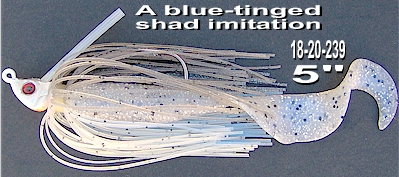
A shad imitation swimming jig.
There's not a lot of noise or vibration that you
are accustomed to with other types of baits (crankbaits,
topwaters, spinnerbaits, etc). Rattles are rarely used on
swimming jigs. Since it's relatively "quiet," a
swimming jig doesn't seem to "announce" itself or alert
fish within an area (as would say, a Rat-L-Trap), and you can
catch multiple fish out of an area.
So much of the strike appeal is visual with
swimming jigs, and color is an important aspect of the appeal.
It's not just the primary color (black, brown, green, etc.), but
second and third accent colors plus metallic flash colors are
considered critical on swimming jig heads, in the skirts and via
soft plastic trailers. Therefore, color, changing colors and
trying new colors throughout the day are key to swimming jig
success. Whitish/silvery patterns keying on shad, shiners or
shore minnows, plus dark patterns (black/brown/greenish/purplish,
etc.) keying on bluegill are most popular. However, imitating any
currently plentiful baitfish or aquatic critter - matching the
hatch - is basic and reliable. Other times, it's not matching
anything in nature that provokes strikes. It's the visibility,
visual affect and attraction of color and flash in the swimming
jig head, skirt and trailer.
Another important point is that long casts are
best. This is not a pitching or flipping approach. Long casts are
an essential part of the application, as far away from the boat
as possible. Plan for the furthest part of the retrieve to come
through isolated clumps of grass and cover, usually within a foot
of the surface. You'll get to see lots of your strikes, and it's
especially exciting to see the bulging wakes of fish that are
zeroing in on the swimming jig from 5-10 feet away in the grass.
Hits tend to come at the end of the cast, when coming across the
top of or skimming the outskirts of fish-holding cover. You don't
necessarily need to jig or pop or pause a swimming jig. Just swim
it steadily. Of course, as it comes into open pockets in the
weeds, let it drop in, or let it sink to bottom on the shady side
of any rock or log it swims over. But most of the time, just swim
it steadily, and get ready whenever it trips over or stutters
through stuff in its path.
As the lightweight jig recoils off anything it
encounters, the deflection moment is a great strike trigger. The
jig gets stunned by the impact, the upright balance becomes
unsettled, and when it comes free it arights itself. Ker-pow! As
a swimming jig deflects off weeds or wood or whatever, bass go
bonkers for it. Since it's a lightweight lure, the supple
fiberguard is more like a bumper or pusher that moves or flexes
the swimming jig off obstructions, while attempting to stay
upright and not bow the hook point over toward the snag. The
fiberguard is not so much there for protection such as with a
heavy duty power jig flipped into the heart of dense cover.
Instead of muscling their way through obstructions, the swimming
jig is designed to shunt aside from them and stay upright without
rolling over, swimming steadily all the while without stopping.
That steady swimming momentum keeps its nose from digging into
snags too as opposed to being hopped, bounced or paused right on
bottom debris.
In open water (sandy flats for instance),
swimming jigs work well too, even though there may not be that
much to deflect off. Yet strikes still tend to come on the end of
a long cast on a steady retrieve. Because of the long distance at
which many strikes happen, the softer than usual fiberguard and
slightly finer than usual needle point hook are important. Due to
the softness of the fiberguard and the needle-like nature of the
hook used, fish come up and grab it, swim off to the side and
sometimes they are already hooked - no hookset per se.
On the other hand, at other times you can suspect
a fish is there but not be sure for several seconds whether it is
a fish or not? While you are reeling in, you'll find fish often
just grab on and swim with the jig. Sometimes the fish may almost
imperceptibly hold on, and as long as you don't pull hard,
neither will the fish. If you just keep reeling, it will happily
keep swimming at you. Since these fish are just grabbing on and
swimming at you at the end of a long cast, you'll find it
necessary to hit them hard. So you must whack them and reel as
fast as possible to try to get a tight connection. Sometimes you
cannot get the hook sunk as they swim at you from a distance, and
they shake the jig out of their mouth before it sticks. That is
one of your weakest moments when you can lose them - within the
first few seconds of the hookset (or lack thereof). Also, a
forgiving drag setting is important for when you get them up to
the boat. If the drag is too tight when they make a final surge
at boatside, they often tend to pull themselves off the hook
after the long-distance fight. That is your second weak moment
when you can lose them - or anytime they leap.
Bottom line, the most productive tactic is to
swim a 1/4 oz jig just under the surface over the tops of
submerged or emergent weeds and wood. It is the 1/4 oz size
that's best around heavy weeds and matted grass beds growing to
the surface and laying over on top. Where there is dense grass,
throw on top of the mats and the 1/4 oz jig will not get hung up
or bogged down on top. Just stop the revolving spool with your
thumb and start reeling before the jig even hits the slop. In
this way, it won't sink into the soft, mushy canopy of greenery,
and you may swim the light jig across the surface of the mats,
pausing it to drop down into sparse open pockets. The 3/8 oz size
will bog down in thick surface grass more than the 1/4 oz size.
Overall, the 1/4 oz size is the mainstay most of
the time. The 3/8 oz size is better when a breeze makes it too
difficult to cast or feel the 1/4 oz size. Plus you may find the
3/8 oz size better suited to the irregular outside edges of a
deeper weed line or to swim over the tops of weeds that are still
submerged deeper under the water. Where the outside weedlines
drop off to open water, the 3/8 oz size excels for swimming
barely above the sloping open bottom in slightly deeper water,
say down to 12 feet.
However, most of the time, the jig is kept up,
swimming high in the water column from just below to within a few
feet of the surface, and fish will barrel up off the bottom, out
from under logs or arise suddenly out of dense weed clumps in
order to swat down the swimming jig up near the top - especially
when the jig bumps and pushes off something. In grass, you can
watch it swimming through grass and see the grass part, fish swim
out and bust it. That's something you'll never grow tired of
seeing.
It's not the crawling, hopping, bottom-bumping
approach taken with other jigs. Quite the opposite. The swimming
jig is kept moving in the top of the water column. Although, if
you did want to pitch, flip or fish bottom with it, a swimming
jig will certainly do that too, as good as any other jig (keeping
in mind it's a medium/heavy hook, not a heavy wire flipping
hook).
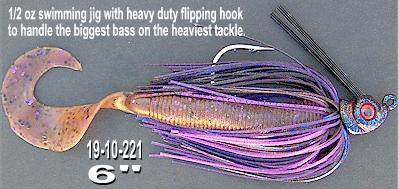
A swimming jig with heavy duty flipping hook to handle
the biggest bass on the heaviest tackle.
There are some brands of swimming jigs now that
do have the heavy duty flipping strength hook to land the biggest
bass with the heaviest tackle. Yet it was only a few years ago
that there weren't any low-angle hook eyes necessary to strike
the delicate swimming balance. If you wanted a swimming jig hook
two years ago, you had to heat and hand-bend the hooks yourself.
But since 2004 when swimming jigs rose to
national attention, low-angle hook eyes in a range of light,
medium and heavy strength wire have been made widely available to
accommodate the many new swimming jig designs out there.
Keep in mind, the "Wisconsin style"
swimming jig is most popular, especially in northern states, and
the hook wire is medium/heavy, but not as heavy as a flipping jig
hook. It has a medium/heavy strength wire for landing big bass
with medium/heavy tackle, say anything from 12 to 16 pound test
line, and a baitcasting rod that's designed for jigs, just more
forgiving than a flipping stick.
A soft plastic trailer is always necessary. A
swimming jig will not work without a soft plastic trailer, which
is often a single tail grub. The single tail of a grub should
always face downward, perfectly centered and straight in line
with the hook without rigging a kink or bend in the grub. The
world's top swimming jig experts tend to recommend Gary Yamamoto
Custom Baits. GYCB offers four sizes of single tail grubs from 4
to 6 inches that go great on all swimming jigs. The four sizes of
Yamamoto grubs are the 40, 18, 19 and 2 series.
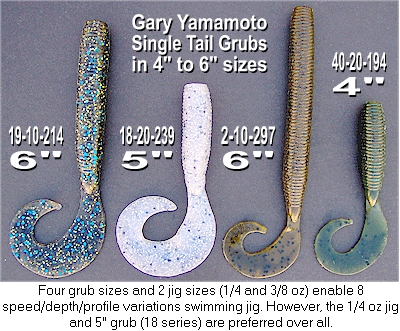
The single tail 18-series five-inch grub works so
superbly that many experts don't use any other grub size or any
other style trailer. However, the range of Yamamoto single tails
from 4" to 6" will work. By varying the four Yamamoto
single tail grub trailers with the two standard jig sizes (1/4
and 3/8 oz), eight different swimming speed/depth and profile
variations are possible - and well worth experimenting with.
Bottom line, a swimming jig always requires a
single tail grub or other trailer - or else a swimming jig simply
isn't effective. |
